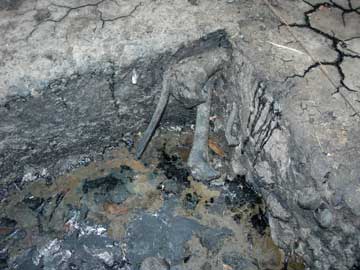|
NEWS NOTES — NEWS
Geomicrobiology
La Brea yields oil-eating bacteria
 D. E. Crowley, UCR |
| Tar pits at Rancho La Brea contain thousands of fossilized bones of animals that were trapped and killed. Now researchers found that the tar pits also house living organisms. |
Fossils are not the only surprises hidden in the Rancho La Brea tar pits in Los Angeles, Calif. Researchers have recently discovered entire new families of bacteria happily living in the toxic asphalt.
Plants growing in two 14,000-year-old asphalt pits at Hancock Park inspired environmental scientists Jong-Shik Kim and David Crowley of the University of California at Riverside to dig out samples of the asphalt. The two researchers had a hunch that the sticky substance housed methane-producing bacteria, which were helping the plants adapt to this toxic environment. They reported April 6 in Applied and Environmental Microbiology online that their suspicions had been confirmed when they sequenced samples of DNA in the tar and found that the samples contained at least 200 new species, genera and families of bacteria and Archaea.
“The ability of bacteria to survive in asphalt has both fundamental and practical importance,” Crowley says. Fundamentally, the find shows that life can adapt to this extreme environment where bacteria can exist with no oxygen and very little water in a toxic mixture of very complex, difficult-to-degrade chemicals, he says. This could tell researchers about how life may exist in extreme environments on Earth and other planets.
Crowley says the bacteria may be very useful. For example, they may be used to clean up oil spills through bioremediation, the process by which bacteria’s enzymes dissolve pollutants in soil and water into a solution that the bacteria can then digest. The bacteria could also enhance oil recovery by bioprocessing impurities out of oil or tar sands, or converting heavy oil or animal waste to energy-producing methane, he says. The bacteria may also aid in the production of new petroleum-based products like plastics, or could seed new biotechnologies.
Next, Crowley and Kim hope to test and sequence more of the tar, to identify the full diversity of enzymes and bacteria in the asphalt. “For now, the asphalt represents a new treasure house of bacteria and genes that can be studied and used,” he says.

 Subscribe
Subscribe


